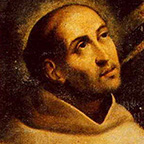A homily for the Third Sunday in Lent
A number of years ago, I used to do mass for a cloistered Carmelite group of nuns. They had a big pilgrim day once a month, I’d always do that mass. When I was being reassigned, they did a little farewell for me. Gave me a card. Then they gave me this gift a cross. Kind of pretty, like a Bishop’s cross.
It had a hook at the top for putting the chain. Priests don’t wear a bishop’s cross. But I looked at it and said, what? A priest needs another cross. You know, priest get crosses all the time. Yet, I got another cross, but I put it on my bookshelves and there it stayed. And every now and then I would just grab it and dusted because it would get dusty.
One time when I did that, I noticed the top or the chain goes rotated. So I said, well, this is different. You know, it should be. So I rotated it and all of a sudden it sprung open. The cross sprung open. Oh, it’s got a secret compartment. This is cool. So I opened it and inside there’s another cross.
So I looked at that and I pulled that cross out and I’ve now have two crosses, the ornate exterior cross and the simple interior cross. But I notice that it has writing, very tiny writing so I scrutinized it terribly. And it said ex lignum Crucis domini nostri Jesu Cristo. That means in Latin from the wood of the cross of our Lord Jesus Christ.
So I look in the center and sure enough, there’s another cross, a very tiny cross in the very center, made out of the wood of the true cross. Now this is getting really cool. I don’t think the sisters knew what they gave me. They probably regifted something that they got just to me, and it sat there for years.
The wood of the True Cross. Well, I think this is how we should do life, and our examination of life in ourselves is the more we look, the deeper we can go. And that’s what I think our readings call us. To go deeper, we have Jesus saying, you know that the Gentile blood was mixed, that their sacrifices by pilot were they guilty or the tower they fell, and people died, were the guilty.
And Jesus is saying, no, it doesn’t work that way. But oftentimes people very infantantly, infantiley say God works that way. If you’re good, God rewards you. If you’re bad, God punishes you, and Jesus is good. Beyond that, it’s a two year old mentality dealing with their parents. God is more than a parent of a two year old. But oftentimes if we think no God is that. God should reward us or punish us, it’s justice.
And if God is not just and it’s like, that’s not God, and who feels like God is what is God? God is nothing. God is dead. John of the cross says that that when we realize or we feel the image of God is incomplete or lacking or infantile and we throw it away, it’s as if God died. But what God is doing is that go deeper and look deeper, and you’ll find another cross, a deeper cross, you’ll find a deeper reality.
That’s the call. And so that’s what he’s even saying with the parable of the fig tree is it’s not just about produce, it’s about life. Let this fig tree live and then it will produce. But we can still say, but it’s not enough. Like if God is omniscient and all loving, why does evil exist? Why do bad things happen to good people?
I just can’t, why do children have cancer? This can’t be God. God can’t allow that. That kind of God is doesn’t exist. God will die according to Saint John of the cross again and again. It’s not God. I just feels that way. It’s your simplistic way of looking at God. And if we look even deeper, we see reality.
The real cross, the true cross in our lives. In God that I think it’s all about. Can we cut through the cross? How can we cut through fear? Can we cut through pain? Can we cut through abandonment? Can we cut through betrayal and love anyway, like Jesus on the cross says father, forgive them. They know not what they do.
Can we do that? That is Christlike love. That is divine love. That’s what we’re called to be. Divine love people. And that’s what I think Jesus calls us to in this gospel, not infantile images of God or infantile images of why evil exists, but a deep, rich knowing that God can even turn, as Saint Paul says to the good for those who love him.




